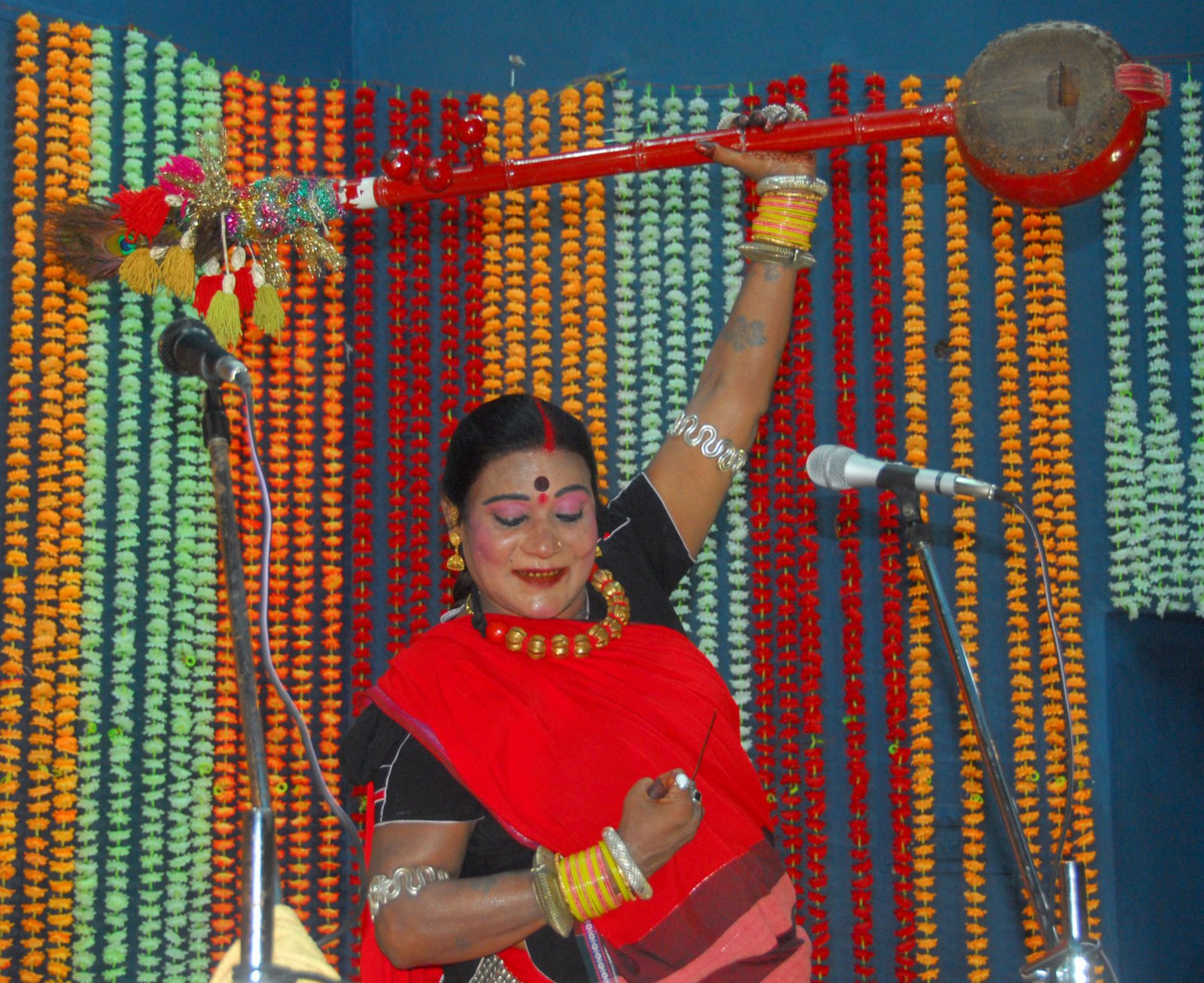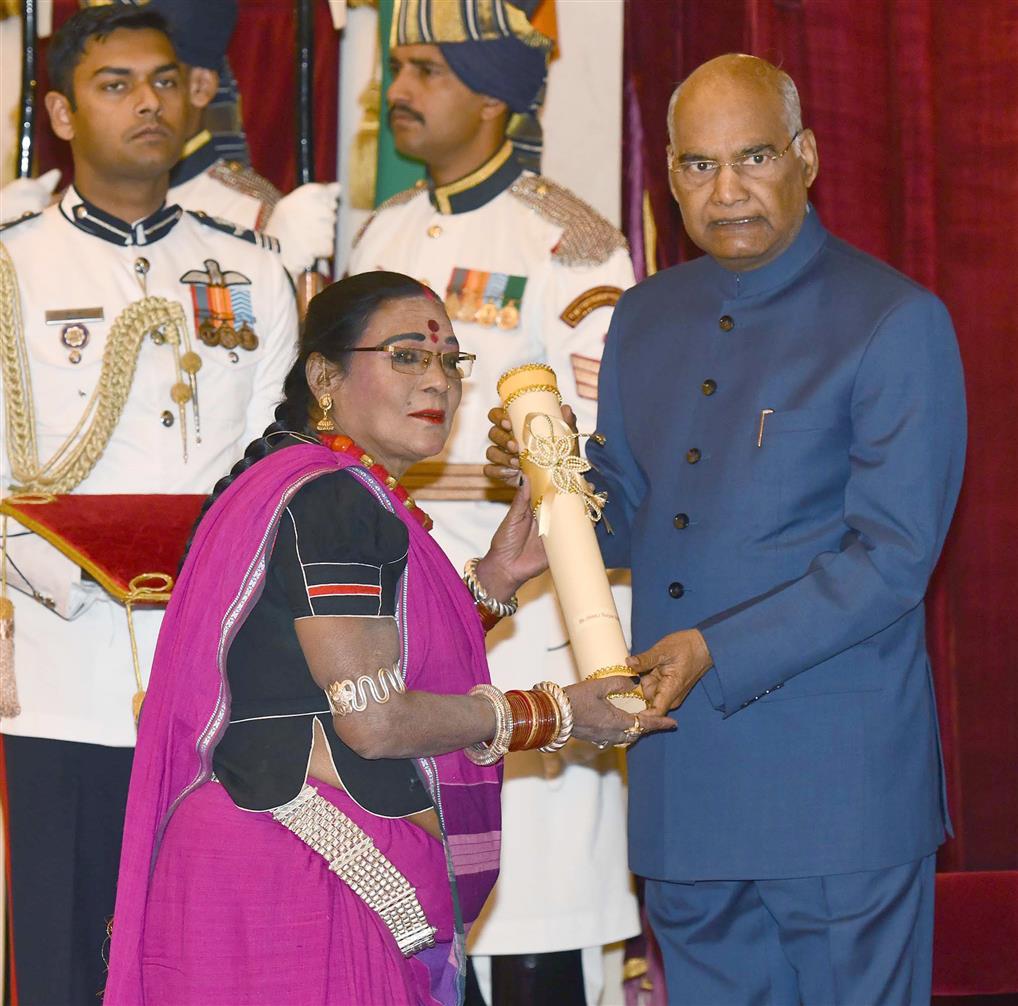|
Pandavani
Pandavani (lit.: Songs and Stories of the Pandavas) is a folk singing style involving narration of tales from the ancient Indian epic Mahabharata. The singing also involves musical accompaniment. Bhima, the second of the Pandava is the hero of the story in this style. This form of folk theatre is popular in the central Indian state of Chhattisgarh and in the neighbouring areas of Madhya Pradesh, Orissa and Andhra Pradesh. Jhaduram Dewangan and Teejan Bai are the most renowned singers of this style. Among contemporary artists, Ritu Verma is popular along with others such as Shantibai Chelak and Usha Barle Origins The origins of this singing style are not known and according to its foremost singer Teejan Bai, it might be as old as the Mahabharata itself, as few people could read in those times and that is how perhaps they passed on their stories generation after generation. Traditionally, Pandavani was performed exclusively by men. Since the 1980s, however, women also began to ... [...More Info...] [...Related Items...] OR: [Wikipedia] [Google] [Baidu] |
Punaram Nishad
Punaram Nishad, born in Ringni, Dist Durg Chhattisgarh, is an Indian folk musician, known for his prowess in the Pandavani, a folk music tradition of Chhattisgarh and the neighbouring states in India. Born in the Indian state of Chhattisgarh, (then Madhya Pradesh) to a Bhajan singer, he started learning the art from the age of 10 under Jhadu Ram Dewangan, considered by many as the father of Pandvani, and aligned with the ''Vedamati'' tradition of Pandavani, which follows a rigid text, and does not permit improvisations. Nishad has composed 18 stories for Pandavani, of which ''Udyog Parv'' is his favourite. He has acted in two plays, ''Agra Bazaar'' directed by Habib Tanvir, and a Naya Theatre production, ''Duryodhan''. His performance has been staged during the ''Beyond the Border Festival Tour'' at Phoenix Arts Centre, Leicester on 28 June 1995. The Government of India awarded him the fourth highest civilian honour of the Padma Shri, in 2005, for his contributions to Indian fork ... [...More Info...] [...Related Items...] OR: [Wikipedia] [Google] [Baidu] |
Culture Of Chhattisgarh
Chhattisgarh (, ) is a landlocked state in Central India. It is the ninth largest state by area, and with a population of roughly 30 million, the seventeenth most populous. It borders seven states – Uttar Pradesh to the north, Madhya Pradesh to the northwest, Maharashtra to the southwest, Jharkhand to the northeast, Odisha to the east, Telangana and Andhra Pradesh to the south. Formerly a part of Madhya Pradesh, it was granted statehood on 1 November 2000 with Raipur as the designated state capital. Chhattisgarh is one of the fastest-developing states in India. Its Gross State Domestic Product (GSDP) is , with a per capita GSDP of . A resource-rich state, it has the third largest coal reserves in the country and provides electricity, coal, and steel to the rest of the nation. It also has the third largest forest cover in the country after Madhya Pradesh and Arunachal Pradesh with over 40% of the state covered by forests. Etymology There are several theories as to the or ... [...More Info...] [...Related Items...] OR: [Wikipedia] [Google] [Baidu] |
Chhattisgarh
Chhattisgarh (, ) is a landlocked state in Central India. It is the ninth largest state by area, and with a population of roughly 30 million, the seventeenth most populous. It borders seven states – Uttar Pradesh to the north, Madhya Pradesh to the northwest, Maharashtra to the southwest, Jharkhand to the northeast, Odisha to the east, Telangana and Andhra Pradesh to the south. Formerly a part of Madhya Pradesh, it was granted statehood on 1 November 2000 with Raipur as the designated state capital. Chhattisgarh is one of the fastest-developing states in India. Its Gross State Domestic Product (GSDP) is , with a per capita GSDP of . A resource-rich state, it has the third largest coal reserves in the country and provides electricity, coal, and steel to the rest of the nation. It also has the third largest forest cover in the country after Madhya Pradesh and Arunachal Pradesh with over 40% of the state covered by forests. Etymology There are several theories as to the ... [...More Info...] [...Related Items...] OR: [Wikipedia] [Google] [Baidu] |
Teejan Bai
Teejan Bai (born 8 August 1956) is an exponent of Pandavani, a traditional performing art form, from Chhattisgarh, in which she enacts tales from the Mahabharata, with musical accompaniments. She has been awarded the Padma Shri in 1988, Padma Bhushan in 2003, and Padma Vibhushan in 2019 by Government of India, besides 1995 Sangeet Natak Akademi Award in 1995, given by Sangeet Natak Akademi, India's National Academy of Music, Dance & Drama. Biography Early life Teejan Bai was born in Ganiyari village, north of Bhilai, to Chunuk Lal Pardhi and his wife Sukhwati. She belongs to the Pardhi Scheduled Tribe of Chhattisgarh state. The eldest among her five siblings, she heard her maternal grandfather, Brijlal Pardhi, recite the Mahabharata written by Chhattisgarhi writer, Sabal Singh Chauhan in Chhattisgarhi Hindi and instantly took a liking to it. She soon memorised much of it, and later trained informally under Umed Singh Deshmukh. Career At age 13, she gave her first publ ... [...More Info...] [...Related Items...] OR: [Wikipedia] [Google] [Baidu] |
Indian Folk Music
Indian folk music is diverse because of India's vast cultural diversity. It is sung in various languages and dialects throughout the length and breadth of this vast nation and exported to different parts of the world owing to migration. Tamang Selo Tamang Selo is a musical genre of the Tamang people and widely popular amongst the Nepali speaking community in India and around the world. It is usually accompanied by Tamang instruments, the Damphu, Madal and Tungna. although modern instruments have found their way into the compositions these days A Selo could be very catchy, attractive and lively or slow and melodious and is usually sung to express love, sorrow and stories of day-to-day life. Hira Devi Waiba is hailed as the pioneer of Nepali Folk songs and Tamang Selo. Her song 'Chura ta Hoina Astura' (चुरा त होइन अस्तुरा) is said to be the first Tamang Selo ever recorded. Waiba has sung nearly 300 songs in a career spanning 40 years. After Waiba's d ... [...More Info...] [...Related Items...] OR: [Wikipedia] [Google] [Baidu] |
Music Of Chhattisgarh
Chhattisgarh is a state of India with strong tribal traditions of music and dance. The state of Chhattisgarh is best known for its deep roots in folk music, which originated from its long history of tribal involvement. History Situated geographically in the centre of India, Chhattisgarh has a rich, historical culture of Indian folk music. This music is closely linked to the heritage of the town and has a strong interaction with relevant dances. The history of music in Chhattisgarh links to the states tribal population which covers about one-third of the community. These tribal communities include Kamar, Kanver, Gond, Birhi, Baiga, Pando, Uranv, Korva, Halba and Binjhwar. Each of which makes up a large part of Chhattisgarh's history and population. The music of Chhattisgarh is closely linked to the role of dance throughout its history. This is due to the religious and ceremonial aspect that music, particularly that of folk, has held the heritage of Chhattisgarh. Folk dance in ... [...More Info...] [...Related Items...] OR: [Wikipedia] [Google] [Baidu] |
Habib Tanvir
Habib Tanvir (1 September 1923 – 8 June 2009) was one of the most popular Indian Urdu, Hindi playwrights, a theatre director, poet and actor. He was the writer of plays such as, ''Agra Bazar'' (1954) and ''Charandas Chor'' (1975). A pioneer in Urdu and Hindi theatre, he was most known for his work with Chhattisgarhi tribals, at the Naya Theatre, a theatre company he founded in 1959 in Bhopal. He went on to include indigenous performance forms such as ''nacha'', to create not only a new theatrical language, but also milestones such as ''Charandas Chor'', ''Gaon ka Naam Sasural, Mor Naam Damad'' and ''Kamdeo ka Apna Basant Ritu ka Sapna''. For him, true "theatre of the people" existed in the villages, which he strived to bring to the urban "educated", employing both folk performers as actors alongside urban actors. He died on 8 June 2009 at Bhopal after a three-week-long illness. Upon his death, he was the last of pioneering actor-managers in Indian theatre, which included ... [...More Info...] [...Related Items...] OR: [Wikipedia] [Google] [Baidu] |
Mahabharat
The ''Mahābhārata'' ( ; sa, महाभारतम्, ', ) is one of the two major Sanskrit epics of ancient India in Hinduism, the other being the ''Rāmāyaṇa''. It narrates the struggle between two groups of cousins in the Kurukshetra War and the fates of the Kaurava and the Pāṇḍava princes and their successors. It also contains philosophical and devotional material, such as a discussion of the four "goals of life" or ''puruṣārtha'' (12.161). Among the principal works and stories in the ''Mahābhārata'' are the ''Bhagavad Gita'', the story of Damayanti, the story of Shakuntala, the story of Pururava and Urvashi, the story of Savitri and Satyavan, the story of Kacha and Devayani, the story of Rishyasringa and an abbreviated version of the ''Rāmāyaṇa'', often considered as works in their own right. Traditionally, the authorship of the ''Mahābhārata'' is attributed to Vyāsa. There have been many attempts to unravel its historical growth and com ... [...More Info...] [...Related Items...] OR: [Wikipedia] [Google] [Baidu] |
Performing Arts In India
Indian culture is the heritage of social norms, ethical values, traditional customs, belief systems, political systems, artifacts and technologies that originated in or are associated with the ethno-linguistically diverse India. The term also applies beyond India to countries and cultures whose histories are strongly connected to India by immigration, colonisation, or influence, particularly in South Asia and Southeast Asia. India's languages, religions, dance, music, architecture, food and customs differ from place to place within the country. Indian culture, often labelled as a combination of several cultures, has been influenced by a history that is several millennia old, beginning with the Indus Valley civilization and other early cultural areas.John Keay (2012), ''India: A History'', 2nd Ed – Revised and Updated, Grove Press / Harper Collins, , see Introduction and Chapters 3 through 11Mohammada, Malika (2007), ''The foundations of the composite culture in India'', Aaka ... [...More Info...] [...Related Items...] OR: [Wikipedia] [Google] [Baidu] |
Usha Barle
Usha may refer to: Geography *Usha (city), an ancient city in western part of Galilee, Israel *Usha, Israel, a modern kibbutz *Usha, Bardhaman, a village in India Personal name Mythology *Ushas or Usha, a Vedic goddess *Uṣā, daughter of Asura Banasura **''Usha Parinayam'' (Telugu: ఉషా పరిణయము; English: Marriage of Usha) Indian drama Given name *Usha (actress) (born 1972), Indian actress and singer in Malayalam movies *Usha (Telugu singer) (born 1980), Indian singer in Telugu language *Usha Choudhari (born 1942), Indian National Congress politician *Usha Gupta, a fictional character in ''The Archers'' *Usha Haley, American academic *Usha Majere, a fictional character in ''Dragonlance'' *Usha Mangeshkar (born 1935), Indian singer *Usha Mehta (1920–2000), Indian Gandhian and freedom fighter *Usha Menon, Indian-British gynaecologist *Usha Sanyal, historian specializing in Asia *Usha Uthup (born 1947), Indian singer Surname * K. K. Usha (1939–2020), Chief Jus ... [...More Info...] [...Related Items...] OR: [Wikipedia] [Google] [Baidu] |
Chetan Dewangan
Chetan may refer to: * Chetan (name), an Indian and Nepalese given name * Chetan, Iran, a village in Mazandaran Province, Iran * Chetan, Kurdistan, a village in Kurdistan Province, Iran * Lucian Chetan Lucian of Samosata, '; la, Lucianus Samosatensis ( 125 – after 180) was a Hellenized Syrian satirist, rhetorician and pamphleteer who is best known for his characteristic tongue-in-cheek style, with which he frequently ridiculed superstit ... (born 1985), Romanian football player See also * Cheta (other) {{dab, geo, surname ... [...More Info...] [...Related Items...] OR: [Wikipedia] [Google] [Baidu] |

.png)





